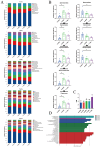Effects of Dietary Net Energy Concentration on Reproductive Performance, Immune Function, Milk Composition, and Gut Microbiota in Primiparous Lactating Sows
- PMID: 39457974
- PMCID: PMC11504852
- DOI: 10.3390/ani14203044
Effects of Dietary Net Energy Concentration on Reproductive Performance, Immune Function, Milk Composition, and Gut Microbiota in Primiparous Lactating Sows
Abstract
This study aimed to determine the optimal dietary net energy concentration for the reproductive performance, immune function, milk composition, and gut microbiota of primiparous sows during lactation. Forty primiparous lactating sows (Landrace × Yorkshire) with similar body backfat thicknesses were randomly allocated into five treatment groups and fed diets with different dietary net energy concentrations of 10.05 MJ/kg, 10.47 MJ/kg, 10.89 MJ/kg, 11.30 MJ/kg, and 11.72 MJ/kg. The results showed that there were no differences in the performance of piglets, while there was a decrease in the daily feed intake of sows (p = 0.079, linear) as dietary net energy concentration increased. With the increasing dietary net energy concentration, the plasma insulin levels of sows increased (p < 0.01, linear), the plasma glucose levels tended to increase (p = 0.074, linear), and the blood urea nitrogen levels tended to decrease (p = 0.063, linear). Moreover, the plasma total superoxide dismutase activity of sows increased (p < 0.05, quadratic) and the plasma malondialdehyde content of sows decreased (p < 0.05, quadratic) by increasing the dietary net energy concentration. Interestingly, with the increase in dietary net energy concentration, the plasma immunoglobulin M content of sows increased, the milk immunoglobulin M, immunoglobulin G, immunoglobulin A and the percentage of milk fat increased (p < 0.05, linear), and the milk secretory immunoglobulin A content also increased (p < 0.05, linear and quadratic). The milk immunoglobulins and milk fat content of sows fed with net energy concentration of 11.72 MJ/kg were highest. Moreover, there were significant differences in the α-diversity, β-diversity, and relative abundance of gut microbiota in sows fed with different dietary net energy concentrations. At the phylum level, Spirochaetota and Bacteroidota in the gut microbiota of sows were mainly affected by increasing the dietary net energy concentration. Furthermore, the correlation analysis showed that milk immunoglobulin content had a significant negative correlation with the relative abundance of Bacteroidota, and plasma malondialdehyde content also had a significant negative correlation with the relative abundance of Spirochaetota. In summary, these results suggest that increasing the dietary net energy concentration to 11.72 MJ/kg can increase immunological substances in milk, improve milk quality, and alter the composition of gut microbiota in primiparous lactating sows.
Keywords: gut microbiota; immune function; milk composition; net energy; primiparous lactating sows; reproductive performance.
Conflict of interest statement
The authors declare no conflicts of interest in regard to the data published in this paper. Guangxi State Farms Yongxin Animal Husbandry Group Co., Ltd., who was involved in the provision of data for this study, did not interfere with co-authors’ access to this study’s data, analyzing and interpreting the data, and preparing or publishing manuscripts independently.
Figures



Similar articles
-
The standardized ileal digestible lysine-to-net energy ratio in the diets of sows to optimize milk nitrogen retention is dynamic during lactation.J Anim Sci. 2024 Jan 3;102:skae094. doi: 10.1093/jas/skae094. J Anim Sci. 2024. PMID: 38558239 Free PMC article.
-
Effects of yeast-derived postbiotic supplementation in late gestation and lactation diets on performance, milk quality, and immune function in lactating sows.J Anim Sci. 2023 Jan 3;101:skad201. doi: 10.1093/jas/skad201. J Anim Sci. 2023. PMID: 37330668 Free PMC article.
-
Energy balance of lactating primiparous sows as affected by feeding level and dietary energy source.J Anim Sci. 2000 Jun;78(6):1520-8. doi: 10.2527/2000.7861520x. J Anim Sci. 2000. PMID: 10875634
-
Effects of dietary energy and protein levels on reproductive performance in gestating sows and growth of their progeny.J Anim Sci Technol. 2019 May;61(3):154-162. doi: 10.5187/jast.2019.61.3.154. Epub 2019 May 31. J Anim Sci Technol. 2019. PMID: 31333872 Free PMC article.
-
Review: Nutrient requirements of the modern high-producing lactating sow, with an emphasis on amino acid requirements.Animal. 2019 Dec;13(12):2967-2977. doi: 10.1017/S1751731119001253. Epub 2019 Jun 14. Animal. 2019. PMID: 31199216 Review.
Cited by
-
Sow reproductive disorders: a key issue affecting the pig industry.Front Vet Sci. 2025 Mar 5;12:1535719. doi: 10.3389/fvets.2025.1535719. eCollection 2025. Front Vet Sci. 2025. PMID: 40110434 Free PMC article. Review.
References
-
- Feyera T., Theil P.K. Energy and lysine requirements and balances of sows during transition and lactation: A factorial approach. Livest. Sci. 2017;201:50–57. doi: 10.1016/j.livsci.2017.05.001. - DOI
-
- Prunier A., de Bragança M.M., Le Dividich J. Influence of high ambient temperature on performance of reproductive sows. Livest. Prod. Sci. 1997;52:123–133. doi: 10.1016/S0301-6226(97)00137-1. - DOI
Grants and funding
- no. 2021YFD1300401/the National Key Research and Development Program of China
- 32472928/the National Natural Science Foundation of China
- CARS-35/China Agriculture Research System
- ZX202401-07/Special Project on Science and Technology Innovation Strategy
- 2023A04J0131/Guangzhou Science and Technology Planning Project
LinkOut - more resources
Full Text Sources

